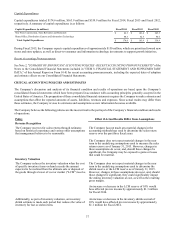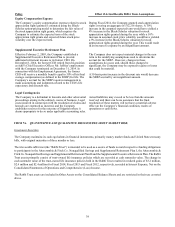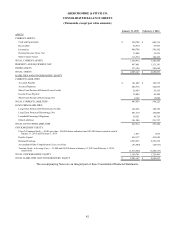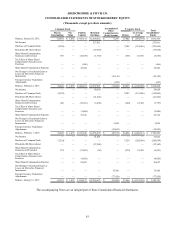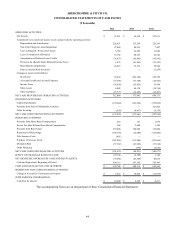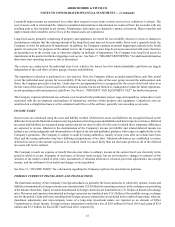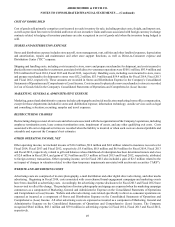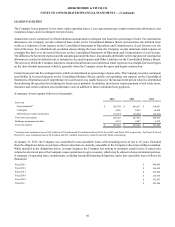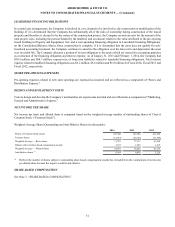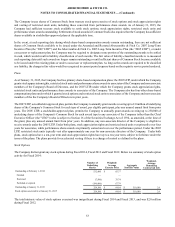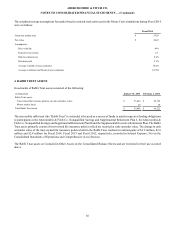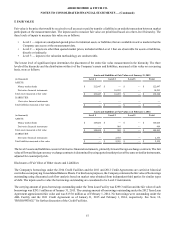Abercrombie & Fitch 2014 Annual Report Download - page 47
Download and view the complete annual report
Please find page 47 of the 2014 Abercrombie & Fitch annual report below. You can navigate through the pages in the report by either clicking on the pages listed below, or by using the keyword search tool below to find specific information within the annual report.ABERCROMBIE & FITCH CO.
NOTES TO CONSOLIDATED FINANCIAL STATEMENTS — (Continued)
47
Leasehold improvements are amortized over either their respective lease terms or their service lives, whichever is shorter. The
cost of assets sold or retired and the related accumulated depreciation or amortization are removed from the accounts with any
resulting gain or loss included in net income. Maintenance and repairs are charged to expense as incurred. Major remodels and
improvements that extend the service lives of the related assets are capitalized.
Long-lived assets, primarily comprising of property and equipment, are tested for recoverability whenever events or changes in
circumstances indicate that the carrying amount of the long-lived asset may not be recoverable. On at least a quarterly basis, the
Company reviews for indicators of impairment. In addition, the Company conducts an annual impairment analysis in the fourth
quarter of each year. For purposes of the annual review, the Company reviews long-lived assets associated with stores that have
an operating loss in the current year or otherwise display an indicator of impairment. The Company tests long-lived assets for
impairments in the quarter in which a triggering event occurs. See Note 17, "SEGMENT REPORTING," for additional information
about how store operating income or loss is determined.
The reviews are conducted at the individual store level, which is the lowest level for which identifiable cash flows are largely
independent of the cash flows of other groups of assets and liabilities.
The impairment evaluation is performed as a two-step test. First, the Company utilizes an undiscounted future cash flow model
to test the individual asset groups for recoverability. If the net carrying value of the asset group exceeds the undiscounted cash
flows, the Company proceeds to step two. Under step two, an impairment loss is recognized for the excess of net book value over
the fair value of the assets. Factors used in the evaluation include, but are not limited to, management’s plans for future operations,
recent operating results and projected cash flows. See Note 6, “PROPERTY AND EQUIPMENT, NET,” for further discussion.
The Company expenses all internal-use software costs incurred in the preliminary project stage and capitalizes certain direct costs
associated with the development and purchase of internal-use software within property and equipment. Capitalized costs are
amortized on a straight-line basis over the estimated useful lives of the software, generally not exceeding seven years.
INCOME TAXES
Income taxes are calculated using the asset and liability method. Deferred tax assets and liabilities are recognized based on the
difference between the financial statement carrying amounts of existing assets and liabilities and their respective tax bases. Deferred
tax assets and liabilities are measured using current enacted tax rates in effect for the years in which those temporary differences
are expected to reverse. Inherent in the determination of the Company's income tax liability and related deferred income tax
balances are certain judgments and interpretations of enacted tax law and published guidance with respect to applicability to the
Company's operations. The Company is subject to audit by taxing authorities, usually several years after tax returns have been
filed, and the taxing authorities may have differing interpretations of tax laws. Valuation allowances are established to reduce
deferred tax assets to the amount expected to be realized when it is more likely than not that some portion or all of the deferred
tax assets will not be realized.
The Company records tax expense or benefit that does not relate to ordinary income in the current fiscal year discretely in the
period in which it occurs. Examples of such types of discrete items include, but are not limited to: changes in estimates of the
outcome of tax matters related to prior years, assessments of valuation allowances, return-to-provision adjustments, tax-exempt
income, and the settlement of tax audits and changes in tax legislation.
See Note 11, “INCOME TAXES,” for a discussion regarding the Company’s policies for uncertain tax positions.
FOREIGN CURRENCY TRANSLATION AND TRANSACTIONS
The functional currency of the Company’s foreign subsidiaries is generally the local currencies in which they operate. Assets and
liabilities denominated in foreign currencies are translated into U.S. Dollars (the reporting currency) at the exchange rate prevailing
at the balance sheet date. Equity accounts denominated in foreign currencies are translated into U.S. Dollars at historical exchange
rates. Revenues and expenses denominated in foreign currencies are translated into U.S. Dollars at the monthly average exchange
rate for the period. Gains and losses resulting from foreign currency transactions are included in the results of operations; whereas,
translation adjustments and inter-company loans of a long-term investment nature are reported as an element of Other
Comprehensive (Loss) Income. Foreign currency transactions resulted in a loss of $2.0 million for Fiscal 2014 and a gain of $2.9
million and $3.3 million for Fiscal 2013 and Fiscal 2012, respectively.


